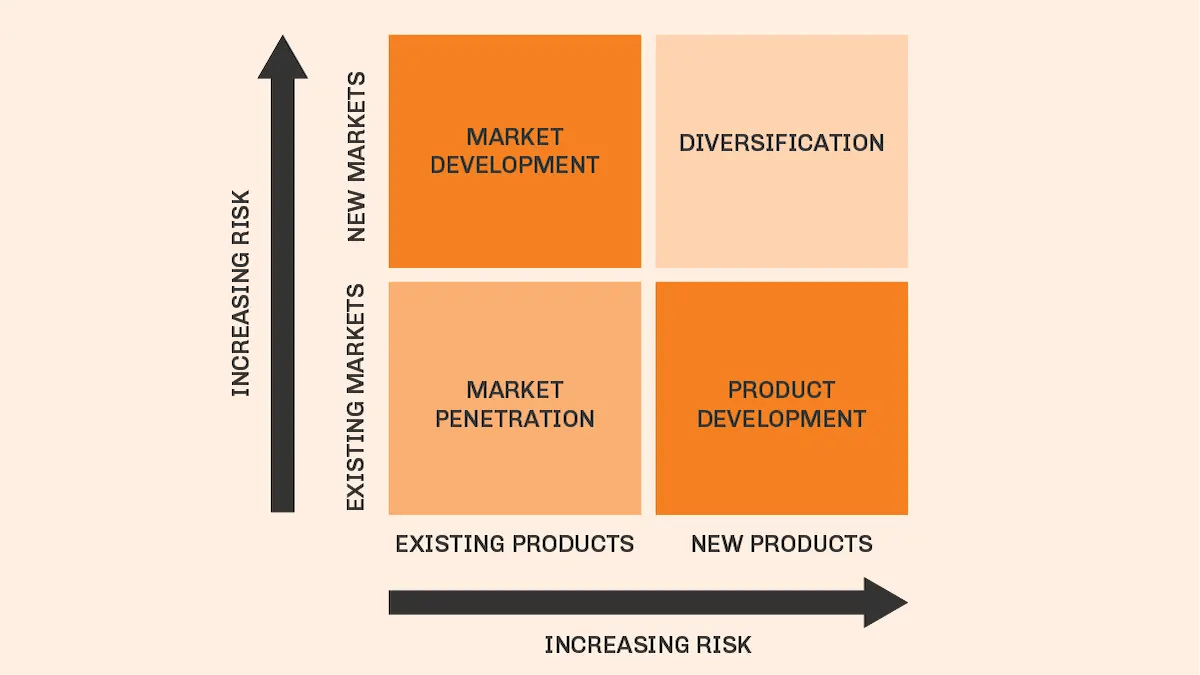Using the Marketing Ansoff Matrix in Ecommerce
There are countless different marketing strategies out there that growing brands can use to streamline their marketing efforts. Also known as the Product/Market Expansion Grid, this two-by-two framework was designed with planning and evaluating growth initiatives in mind.
This system differs from other marketing models as its primary purpose is to help focus on potential risks associated with a company’s growth strategies. It can take a little while to learn, but once you understand the basics—it's an easy-to-apply system that helps many brands with their growth strategy.
Are you ready to see our comprehensive guide to the Ansoff model?
| Product Recommendations Simplified |
What is the Marketing Ansoff Model?
The Ansoff Matric was designed to deliver a quick and simple way to think about the risks of growth. Developed by H. Igor Ansoff and first published in the Harvard Business Review in 1957, this strategy breaks down the process into four strategies you can use to grow your business while analyzing the risks associated with each one.
The Ansoff Model is set up as a grid that goes through four different strategies, the main concept is that each time you move into a new quadrant, whether horizontally or vertically, the risk associated increases.
Here are the four quadrants included:

Market Penetration
Location: Lower Left Quadrant
The matrix starts with market penetration, which is often hailed as the safest of the four options in the quadrant. This is where your company focuses on expanding sales of your existing product in your existing market.
This is typically how you execute this step:
- Increase marketing efforts
- Streamline distribution processes
- Decrease prices to attract new customers within your market
- Acquire competitors in the same market
Typically, there is very little risk involved and very few surprises, because you already know your product and you know the existing market—it’s all about growth within this familiar space.
Example of Market Penetration: A cookie company currently sells its products in local markets, but wants to expand their footprint by moving into larger, national grocery store chains.
Product Development
Location: Lower Right Quadrant
The next location in the quadrant is product development. This area is slightly more risky than market penetration as it involves introducing a new product into an existing market. While you’re familiar with your market and how it ticks, you still can’t be completely sure how the new product will perform.
Here are some ways to apply this:
- Invest in developing a brand-new product
- Purchase the right to produce and sell another brand’s products
- Create a new offering with a white-label product
This is a popular approach to building brand loyalty with your existing customers and within your existing marketing.
Example of Product Development: A leggings company realizes that many of its customers are looking for more workout gear and decides to expand into workout tops. They are selling to the same market, but their product line has expanded.
Market Development
Location: Upper Left Quadrant
Presenting an equal amount of risk is the market development quadrant. This step of the matrix involves putting an existing product into an entirely new market. If you have found a new use for your product or are adding new features or benefits to it—then you may be “switching markets.”
Approaches to market development include:
- Catering to a new customer segment within your target audience
- Expanding into a new regional or domestic market
- Going from a domestic into a foreign market
There’s a substantial amount of risk to doing this, but in the end, you know your product, even if it has new features, so have some stability with this decision.
Example of Market Development: If a pillow company currently sells its products around Charleston, SC, and in the south, but wants to expand to the Northeast, this would be an example of market development.
Diversification
Location: Upper Right Quadrant
This is the riskiest of the four options in the quadrant because it involves two major risks. First, you’re introducing a new product into the market with no proven track record and no concept of how it will appeal to audiences. Second, you don’t know the market, every market is different, even if it is similar to your existing one.
There are typically two approaches to diversification strategies:
- Related diversification. Where there is a relation between the existing business and the new product or market, such as a cotton sweatshirt company getting into the cotton bedding business.
- Unrelated diversification. When there is hardly any correlation between the existing company and their new product and market.
Each of these approaches has its benefits and challenges, but both can present some major risks.
Example of Diversification: Amazon was originally an online book retailer, before expanding into selling virtually anything and everything you would ever want. Now they have diversified into being their own entertainment studio by creating movies and TV shows specifically through their platform.
How Do You Apply the Ansoff Matrix?
Understanding the components of the Ansoff Matrix is only half the battle. You also need to know how to apply it in real-world situations. Here are some tips for applying this matrix in your business:
- Write out the advantages and risks for each quadrant in the matric so you can be confident in your decisions moving forward.
- Evaluate your options and write down what each of your options is within each of the quadrants.
- Assess your risk tolerance for each quadrant and write out what the potential risks would be with each of them. Obviously, certain quadrants are going to have different potential risks.
- Choose a growth strategy. You should be able to choose a strategy that is best for your business and remember that many times, companies will revisit the matrix later on when they’re ready to expand more. The matrix can always be revisited.
The Ansoff Matrix is a simple and straightforward approach that can help any brand, whether you are in the Ecommerce space or any other sector, with their plans for growth in the future.
 You've made it this far and you've learned so much. Congratulations!
You've made it this far and you've learned so much. Congratulations!
If you're looking to learn more about marketing or Ecommerce in general, feel free to reach out to us at: solutions@undigital.com
You May Also Like
These Related Stories

Ecommerce Marketing Strategies That Actually Work

The 7Ps of the Marketing Mix: Accelerate Your Strategy


